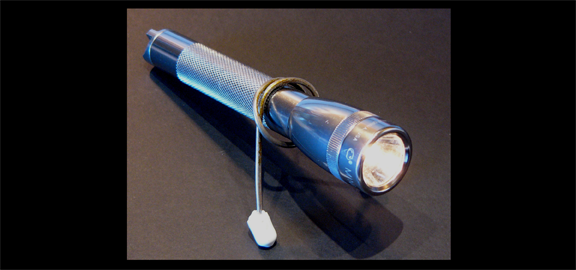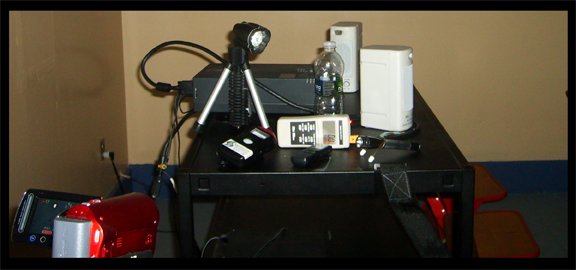
By Greg Latimer, Mysterious Destinations Magazine Research Director
First in a series that covers some of the tools used for seeking the unknown.
(The end of this article includes a link to a compelling video of a flashlight session conducted in conjunction with copper dousing rods.)
Among the many tools for detecting paranormal activity that have come into play recently is the flashlight… Not just for illuminating darkened hallways, but for actually having a dialogue of sorts with paranormal entities. However, as with many devices used in discerning paranormal activity, this method remains controversial. I will discuss the controversy regarding flashlight sessions later in the article.
Flashlight Session Version 1.1
In case you’re not familiar with flashlight sessions, here’s how they work…
For this example, and throughout the article, I will work with the Mini Maglite that uses a twisting motion on the front element of the light to turn the device on and off. (I have seen these sessions on television done with the small stand-up flashlights that use a switch to turn them on and off, however I have never used these personally.)
Now here’s the “twist”, and the source for much of the controversy. Twist the top element of the flashlight so it is not quite on. This is done best by slowly turning the element until the light goes on, and then slowly turning it in the opposite direction until it goes off.
By doing this you have now made the flashlight and all of it’s intricate inner workings an extremely sensitive instrument… Sensitive to vibrations, electrical build-ups, minute changes in atmospheric conditions, and perhaps to the presence of a paranormal entity.
Place the “adjusted” flashlight on a flat surface such as a table; preferably a solid, steady one. I use a small bipod made from a twisted coat hanger that has a loop large enough to slide over the slim bottom end of the flashlight and small enough to come to a stop at the larger front end of the flashlight to ensure even steadier position and more separation from the surface.
Q & A With a Flashlight
The line of questions provided here may also be used for electromagnetic field (EMF) detector sessions, where the EMF detector is used to register responses.
We usually like to preface our initial questions by advising whatever entities may be present that we are here to visit, that we only want to communicate, and that we don’t wish to harm anything nor do we want to drive anything off or change what they’re doing.
Now you can begin your flashlight (or EMF) session with simple questions that require only “yes” responses, such as “Is there anyone here who would like to speak with us? Please turn on the light for yes.” Or, if you have specific information on an entity named “Joe” you might inquire “Is Joe here? Please turn on the light for yes.”
Needless to say, the light doesn’t always turn on. Some questions might require repetition. The learning process can only be achieved through experience and the willingness to try and try again.
Several things to remember about the questions you pose… Try to pose them in a respectful tone but with enough authority to communicate that you expect an answer. Never (and I mean never) ask insulting questions, taunting questions or questions that might be perceived as threatening.
Should the flashlight respond to your questions by lighting up, you should respond by saying, “Thank you. Can you please turn the light off.” You must wait, sometimes patiently, for the light to fade. When the light does fade, then say, “Thank you for turning off the light”. Now you’re ready for further inquiries.
Some common questions, once a “dialogue” has been initiated, include, “Are you a woman?” or “Are you a man?” and “Are there others here with you?”
There are also lines of questions to help you narrow down facts through a process of elimination (since you’re limited to only one answer) such as “Did you die in the 1700’s? Please turn on the light for yes.” If there’s no response, then move on to “Did you die in the 1800’s? Please turn on the light for yes” and so on.
The response to your questions will vary, with the light sometimes suddenly shining bright immediately following a question and sometimes flickering on to a weak shine.
The Controversy

It’s the varied responses outlined above and the “tweaking” of the flashlight that has made the flashlight sessions so controversial, and not without reason. Paranormal investigators (and others) who refer to flashlight sessions as the “flashlight trick” have outlined a myriad of reasons why flashlights are either inaccurate, or a complete sham.
They cite, in particular, the initial adjustment of the flashlight essentially causes it to malfunction. The Mini Maglites are actually pretty delicate instruments, filled with “floating” contact elements and other mechanisms that are constantly under tension from the spring at the base of the flashlight as soon as the forward element is twisted, whether the light bulb is on or off.
The critics point out that operating the flashlight while it is malfunctioning may cause it to be activated by even the smallest stimulus, and they cite elements such as moisture, vibrations and electrical build-ups within the instrument that cause the light to go on and off without the presence of any paranormal entity. There are even videos of people talking to ridiculous elements such as their gym socks or the “flashlight god” that show the flashlight going on and off in apparent response to questions posed to these elements.
Mysterious Destinations Magazine agrees with these critics. Every point they’ve made about the operation of the flashlight and the variety of sources that can trigger the light bulb seem to be reasonable and correct.
However, we do point out that the same circumstances that lead to such false positives also make the flashlight extremely responsive to the electromagnetic fields generally agreed to be generated by paranormal entities.
That is why we seldom use the flashlight sessions as a “stand alone” indication of possible paranormal activity. Instead we endeavor to use a combined array of instruments to help us create a preponderance of evidence pointing to the possibility of paranormal activity.
Videos Showing Use of Flashlight with Supporting Device
In the article “Close Encounters at the Johnny Cash House in Jamaica” posted in this issue of MysteriousDestinationsMagazine.com we have an EMF detector registering an anomalous EMF field near the flashlight. (To view that video, click here.)
We also have a set of 5 videos taken at the Tipsy Butler B&B in Maine during a particularly active night that show a flashlight “responding” to questions almost simultaneously to matching responses from copper dousing rods. (To view that video, click here.)
